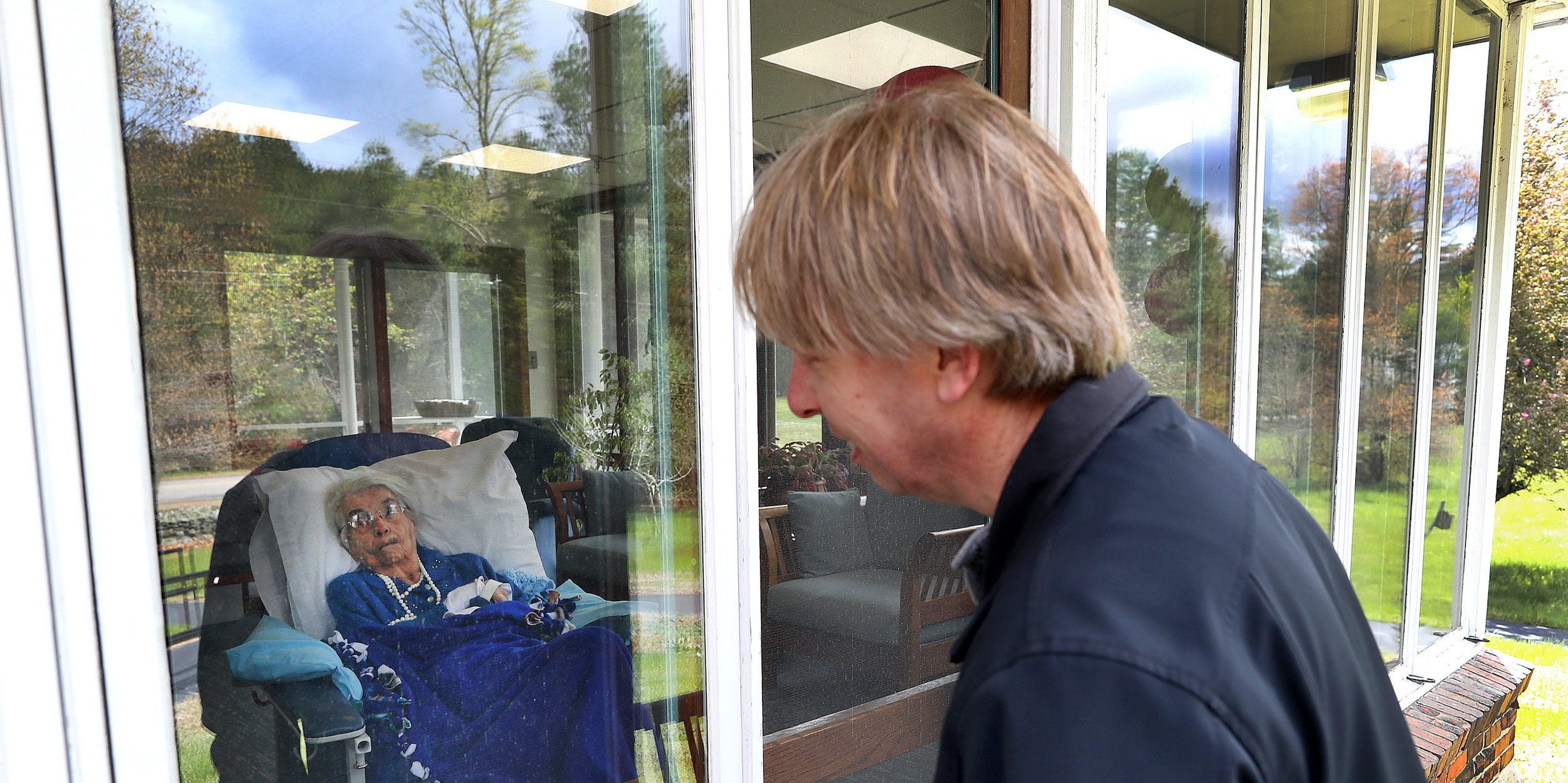
John Tlumacki/The Boston Globe via Getty Images
- Nursing homes have been badly hit by the COVID-19 pandemic.
- Workers in these facilities have encountered myriad challenges, including limited PPE, inconsistent testing, and fear of potential exposure.
- Many have avoided seeing their families and quit side gigs to keep themselves, their residents, and their loved ones safe.
- Visit Business Insider’s homepage for more stories.
Nursing homes have been especially hard-hit by the COVID-19 pandemic and workers in those facilities have been forced to make some difficult decisions on a professional and personal level.
While nursing homes only make up 1% of the US population, according to the Associated Press, they account for a significantly larger percentage of COVID-19 infections compared to the overall population.
As of this writing, there are 8.3 million people infected with the coronavirus in the US, and over 222,000 have died.
According to data from the Centers for Medicare and Medicaid Services, at least 252,939 COVID-19 cases have been recorded in nursing homes nationwide, with an additional 143,848 suspected cases. More than 59,600 deaths have been recorded since the week of October 4, the date of the most recent available data.
Tamara Konetzka, a University of Chicago public health professor who has been researching the impact of COVID-19 on nursing homes, told Insider at least 80% of all nursing homes have had at least one case.
Konetzka said there's been much progress made since the start of the pandemic, and researchers have now learned that after locking down facilities, staff are one of the key ways the virus enters nursing homes.
"We know when patients are coming in positive from the hospital, but staff come and go daily and no matter how much we test people, it's going to be hard to prevent that," Konetzka said.
Workers were in the dark about the pandemic at first
While cases in these facilities have spiraled, several nursing home workers told Insider, their facilities did not initially tell them what was going on or provide them with adequate information and supplies to keep safe.
Terry Ellsbury has worked at a Michigan nursing home that houses predominately older patients for 23 years, helping them shower and take care of every day essentials. Ellsbury told Insider that in late February and early March, residents began to get sick. She initially thought it was just bad cases of the cold and flu, but when residents had to be transported out of the facility, she began to wonder what was going on.
"I was like 'they're sending too many people out at one time on all three floors.' I was like, something is going on, but we never knew what it was," Ellsbury said.
After a few residents had succumbed to the virus, workers were told they had died of COVID-19, but were still not informed about what the disease, nor were they provided with personal protective equipment, Ellsbury said. It was only after workers became ill during those initial weeks of the pandemic that they started demanding gloves and masks, and other PPE from management.
Emma Woodard works at a nursing home in Minnesota and has COPD, a type of inflammatory lung disease that can cause breathing difficulty. Woodard, who does activities with nursing home patients, told Insider she was frightened at the start of the pandemic but realized it was her only way to earn money.
"It was really hard because I had to think of me and my family and what the impact would do to me. I was afraid," Woodard said.
She recalled her fear at the start of the pandemic, and lingering worries that she could catch the virus or unintentionally pass it on whenever she interacted with a patient.
PPE and testing to keep staff and residents safe
Woodard is also in charge of ordering supplies like PPE for the nursing home she works in. She explained that while it was a challenge to figure out the necessary amount in the beginning, she felt like her employer was able to order adequate gloves and masks to ensure people were protected.
Both staff and residents in Woodard's nursing home get tested weekly, and they receive their results the following day. In Ellsbury's facility, staff get tested once a week as well but don't learn their results until the following week. Both women said the tests were painful, but said they felt reassurance knowing everyone was getting tested frequently.
"It's stressful because you can't just say, I don't want it. You have to do it. Getting your nose pricked every week, it burns. Sometimes they go too far," Woodard said.
The federal government has made promises to increase aid to nursing homes. Earlier in the summer, FEMA sent a 14-day supply of equipment to nursing homes across the country, however many said the equipment was faulty, The New York Times reported in July.
Woodard said her facility received some of the equipment allocated by the government, describing them as "cheap." She said the surgical masks they received were poorly fitting or would easily break.
"Some of them were too small to where it was hurting the ear," Woodard said.
Others like Suzanne Fabian-West, a nursing home worker in Minnesota, said her facility received some of the supplies.
"We did get some supplies that I was told were government supplies. And that was a joke. They must have cleaned the basement out. The plastic on them was so old that it cracked when you touched it. They were outdated and completely and totally inadequate. I can't believe that they sent them to us," Fabian-West told Insider.
Workers sacrificed additional income and family contact
West is among the many who had to adjust her personal routine due to the pandemic. Fabian-West used to work additional jobs, like playing music or working at a flower shop, for extra income. She has since stopped her additional gigs, losing up to $2,000 a month.
"In addition to not being able to do it because of restrictions, I also would not want to do it because I'm afraid of bringing that virus to the vulnerable adults that I take care of and work with," she said.
But beyond the personal toll, Fabian-West said the pandemic has made it harder to do her job and interact with residents. She does life-enrichment activities with residents, many of whom cope with conditions like dementia, so it's difficult to explain to them what's going on.
"It's been five months of not having that and people being quarantined to their units or their rooms and when they're unhappy, everyone's unhappy. They don't want to stay in their rooms. They don't want to keep a mask on, they don't want to stay six feet apart. They want to talk to their neighbors and friends. They want their family to visit. So there's definitely more depression. There is a lot more frustration among the residents and the staff," she said.
The pandemic has also meant that she's not able to bring in volunteer instructors for large group activities as she might have before.
"It is very difficult to do; we can't force residents to keep a mask on, especially people with dementia behaviors. At best, we keep people spread apart and try to do activities on each unit as opposed to each floor. So we're bringing less people together, which makes three or four times more work for the department," she said.
While she gets tested regularly, Fabian-West says she still worries about catching COVID-19 or infecting residents because she doesn't trust that a negative test result truly means someone is free from the virus and could unknowingly spread it.
"Naturally it's scary, but my fear is the same every day when I come in. With a virus that can be virtually undetected as far as symptoms, everybody talks about screening and testing. Well, how much of this testing are false negatives, false positives. I don't trust it," Fabian-West said.
Kontetzak said that in area where the virus is widespread, it's important to test staff twice a week, in accordance with guidelines from the Centers for Disease Control and Prevention.
"If you haven't had a case for a while, or if you're not in a hotspot it doesn't have to be quite as often," she said.
Testing has been a fundamental part of ensuring the virus doesn't spread in these facilities, especially with workers who may work in more than one nursing home, Yvonne Slosarski, communications coordinator for the Service Employees International Union Local 1199 chapter, told Insider.
Slosarski said some of the issues contributing to the spread are actually longstanding, and they have been exacerbated by the pandemic, such as workers having limited sick days or facilities being short-staffed.
She recalled an incident where one worker caught COVID-19 at work and was off-duty for six weeks to recover. And because she didn't have enough sick days, she had to file for unemployment while she was trying to recover from the virus.
Slosarski, whose organization represents over 2,000 members in long-term care facilities in 70 locations in the Maryland and Washington, DC, area said it has been helpful that Maryland implemented mandatory weekly testing for nursing home workers.
"Testing was a huge problem, even when it was state-mandated. Several institutions just either weren't doing it or the results were not getting back for months," Slosarski said.
"One person found out that she had been COVID-19 positive a month prior when she took the test and the whole time she had been going to work and also caring for her children," she said.
The Herald Mail reported in August that in some facilities, test results were not coming back until weeks later. The newspaper also reported facilities were struggling to take on the cost of weekly testing after Maryland stopped paying for it in August.
The Trump administration announced in September that it plans to ship 150 million rapid coronavirus tests to states. Nursing homes were slated to be among the first to receive these rapid tests, which could give results within minutes. However, some experts have warned they may not be as reliable as standard COVID-19 tests, The New York Times reported.
As cases across the US continue to rise, fear and worry remain for those living and working in nursing homes.
"Nursing homes are going to be at risk, given their setting, given that it's a congregate environment with older adults who have underlying health conditions, and given that they need hours of hands-on care each day," Konetzka said.

